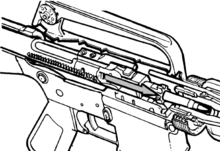.223 Wylde chamber
A .223 Wylde chamber is a hybrid rifle chamber designed to allow .22 caliber barrels to safely fire either .223 Remington or 5.56×45mm NATO ammunition.

History and rationale
In 1957, during research into development of a military .22 caliber rifle the Remington .222 Special was created by a joint effort of Fairchild Industries, Remington Arms and U.S. Continental Army Command (CONARC). Due to there being several .222 caliber cartridges under development, the .222 Special was renamed to .223 Remington. The cartridge became the standard intermediate cartridge for the United States Army in 1962, as the M193 Cartridge.[1]
In 1972 Fabrique Nationale (FN) created a new type of service ammunition for NATO. It was based on the .223 Remington cartridge being used by the US Army, but had greater range and effectiveness. The first iteration of this ammunition was type designated SS109.[2]
Due to slight differences in the chamber dimensions between the .223 Remington and 5.56×45mm NATO (SS109, M-855), the two cannot be used interchangeably. However .223 Rem cartridges can safely be fired from a 5.56 NATO chamber[1] with reduced accuracy, but not safely vice versa due to .223 Rem chambers have lower pressure ratings than the 5.56 NATO. As most rifle makers moved to support the 5.56mm NATO specification, the reduced accuracy was considered a problem.[3]
Chamber dimensions
Bill Wylde of Greenup, Illinois compared the two cartridges and changed the chamber of the rifle's barrel to a specification called .223 Wylde chamber or .22 Wylde chamber. The chamber is made with the external dimensions and leade angle found in the military 5.56×45mm NATO cartridge and the 0.2240 inch freebore diameter found in the civilian SAAMI .223 Remington cartridge.[4] Rifles with a .223 Wylde chamber will typically accept both .223 Remington and 5.56×45mm NATO ammunition.[4] Note that while the .223 Remington and 5.56×45mm NATO chambers have slightly different dimension, the cartridges themselves are identical in dimension.[4] The chamber dimension differences are often confused with the cartridge dimensions and it is often erroneously thought that the cartridges have different dimensions. The cartridges are loaded to different pressure levels (with the 5.56 NATO being greater), however.[5] (The NATO dimensions offset the higher pressure with a longer throat - often confusing some to think the cartridge itself is longer). This chamber allows the use of both pressure levels safely while also increasing accuracy potential across the range of potential pressures.[3]
Wylde's hybrid chamber was designed to exploit the accuracy advantages of the .223 Remington chambering without problems concerning over pressure or compromising the functional reliability of semi-automatic firearms like the AR-15 family of modern sporting rifles when using 5.56×45mm NATO military ammunition.[6] Coincidentally, it shoots the relatively long and heavy 80-grain (5.18 g) bullets commonly used in the Sport Rifle Competition very well and is one of the preferred chambers for that use.[7] The Wylde chamber is used by rifle manufacturers who sell "National Match" configuration AR-15 rifles, barrels and upper receivers.
References
- Barnes, Frank C. (19 December 2014). Cartridges of the World: A Complete and Illustrated Reference for Over 1500 Cartridges. Iola, Wisconsin: "F+W Media, Inc.". p. 88. ISBN 978-1-4402-4265-6.
- Walter, John (25 March 2006). Rifles of the World. Iola, Wisconsin: Krause Publications. p. 124. ISBN 0-89689-241-7.
- Sweeney, Patrick (23 February 2010). Gunsmithing - The AR-15. Iola, Wisconsin: Gun Digest Books. pp. 49, 139. ISBN 1-4402-1457-3.
- Fitzpatrick, Brad (29 October 2015). "Clearing the Caliber Confusion: .223 Wylde vs. 5.56 NATO". AWC.
- McAdams, John (12 May 2014). "The dangers of mixing up 5.56×45mm NATO and .223 Remington rounds". Multi Briefs.
- Muramatsu, Kevin (21 November 2014). Gun Digest Guide to Customizing Your AR-15. Iola, Wisconsin: "F+W Media, Inc.". p. 231. ISBN 978-1-4402-4279-3.
- Wormley, Stanton (14 August 2014). "The AR-15 for Home Defense: Reliability". American Rifleman.